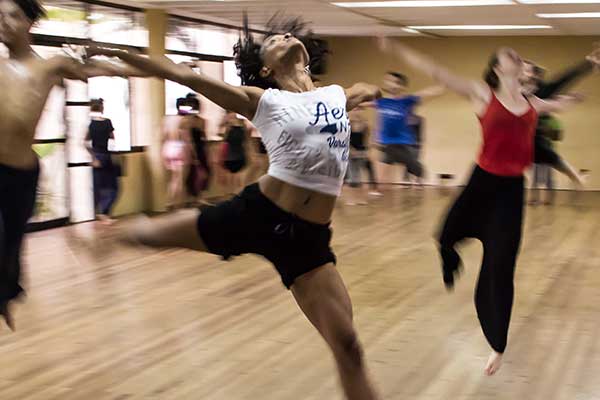Dancing Can Reverse Aging In The Brain

Julia C. Basso, PhD
A healthy and functional brain requires healthy, intact cells that fire effectively.
Action Potentials
Neurons generate action potentials, which are the brain’s primary source of currency. Action potentials are electrical signals that travel down the neuron. When the action potential reaches the end of the neuron (the axon terminal), the electrical signal is converted into a chemical signal, which enables communication between neurons. The axon of the neuron is covered by the myelin sheath, which is a layer of fat that helps insulate the neuron to allow for faster conduction of the action potential. This protective covering helps expedite communication between the neurons.
Collectively, the axon and myelin are what neuroscientists refer to as the white matter of the brain. As we age, loss of white matter is a common occurrence. This disruption in white matter and the general integrity of the neuron is thought to underlie age-related decline in cognitive functioning and memory.
Related Article: A Conversation Between Dance And Neuroscience

White Matter Factors
Ideally, something could be done to deter both the age-related degeneration in white matter and its associated cognitive impairment. Recently, scientists have found that individuals with higher levels of physical activity and greater levels of cardiorespiratory fitness have improved white matter density (also referred to as integrity). However, few interventional studies have been conducted to examine whether engaging in a physical activity program can lead to improvements in white matter integrity.
Therefore, Drs. Agnieszka Burzynksa and Art Kramer and their team at the University of Illinois conducted a study to examine the effects of 6 monhts of physical activity on white matter in a group of older adults (Burzynska et al., 2017).
Related Article: Exercise Increases Neurons In The Brain
The Study
Data from 174 individuals between the ages of 60 to 79 were collected both before and after 6 months of participation in either a stretching and toning program, a walking program, a walking program with nutritional supplements, or a dance program.
The walking program was intended to be a purely aerobic workout, whereas the dance program added the benefits of cognitive and social stimulation. All dance sessions were led by experienced dance instructors. Choreographic sequences were taught during each class, with the choreography becoming progressively challenging over the course of the 6-month program. Dance styles included group social dance styles such as Contra dancing and English Country dancing.
Before and after 6 months of physical activity training, participants had their brains scanned with a magnetic resonance imaging (MRI) scanner to determine the density of white matter in different regions of the brain.
Results
 Compared to all other physical activity conditions, dance had a special effect on one region of the brain known as the fornix.
Compared to all other physical activity conditions, dance had a special effect on one region of the brain known as the fornix.
Over the course of 6 months, the density of white matter in the fornix decreased for participants in the walking, walking plus nutrition, and stretching/toning groups. Dancers, however, showed a significant increase in fornix density. The fornix is a brain region that carries information from the hippocampus to other regions of the brain, such as the hypothalamus and basal forebrain. This region is primarily involved in the encoding and retrieval of memories, and degradation of this area has been linked to memory impairment.
In the current study, the researchers found that the density of the fornix was related to processing speed or the ability to process and respond to information. No improvements were seen in any of the cognitive tasks assessed, which the authors contribute to the fact that you may need more than 6 months to see improvements in cognitive functioning (even if there are changes in the brain).
Bringing this information back to the level of the neuron, these findings indicate (at least theoretically) that dancing helps neurons to better able carry and communicate information to adjoining neurons.
Related Article: Fitness Helps Brain Function As We Age
Takeaway
In conclusion, this study revealed that the effect of aging on the brain can be seen at time intervals as short as 6 months. Dancing, an aerobic activity that includes elements of social interaction, cognitive stimulation, and emotional engagement, may be one of the best physical activities to protect the brain from aging-induced neurodegeneration.
Rather than doing your regular aerobic exercises, try signing up for a dance class – your white matter may thank you for it!
Related Article: Dance Harmony In Woodstock
You Might Like:
Do Younger & Older Brains Respond Differently To Dance?
Aga Burzynska, PhD Dance – as a ritual, therapy, and leisure activity – has been known for thousands of years. Today, dance is increasingly used as therapy for cognitive and neurological disorders such as dementia, multiple sclerosis,...Dancing Can Reverse Aging In The Brain
Julia C. Basso, PhD A healthy and functional brain requires healthy, intact cells that fire effectively. Action Potentials Neurons generate action potentials, which are the brain’s primary source of currency. Action potentials are electrical signals...Dancing Helps Heal Individuals With Parkinson’s Disease
Julia C. Basso, PhD Parkinson’s disease (PD) is a neurodegenerative disorder that is characterized by problems of movement. Though the disease normally manifests after the age of 60, in rare circumstances, the disease may develop...A Conversation Between Dance And Neuroscience
Julia C. Basso, PhD Dance and neuroscience may seem like two distinct fields, but Jody Oberfelder, director, choreographer, and filmmaker, knows that they intersect in intricate ways. Her recent work, The Brain Piece, just had...References:
Burzynska, A. Z., Jiao, Y., Knecht, A. M., Fanning, J., Awick, E. A., Chen, T., … & Kramer, A. F. (2017). White matter integrity declined over 6-months, but dance intervention improved integrity of the fornix of older adults. Frontiers in aging neuroscience, 9.













